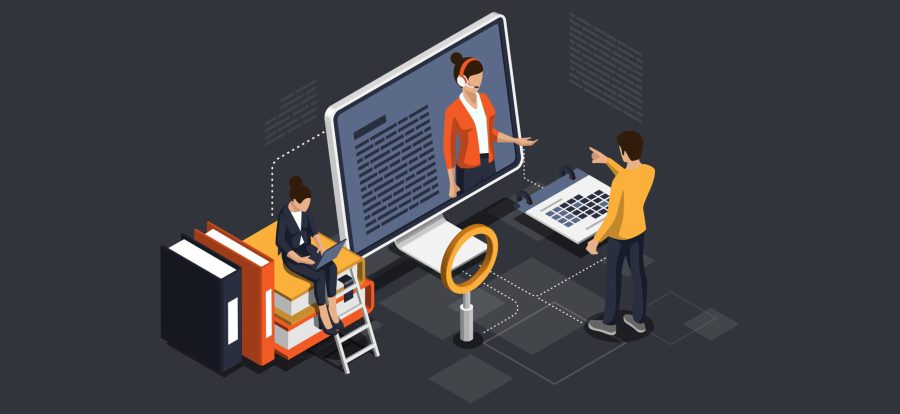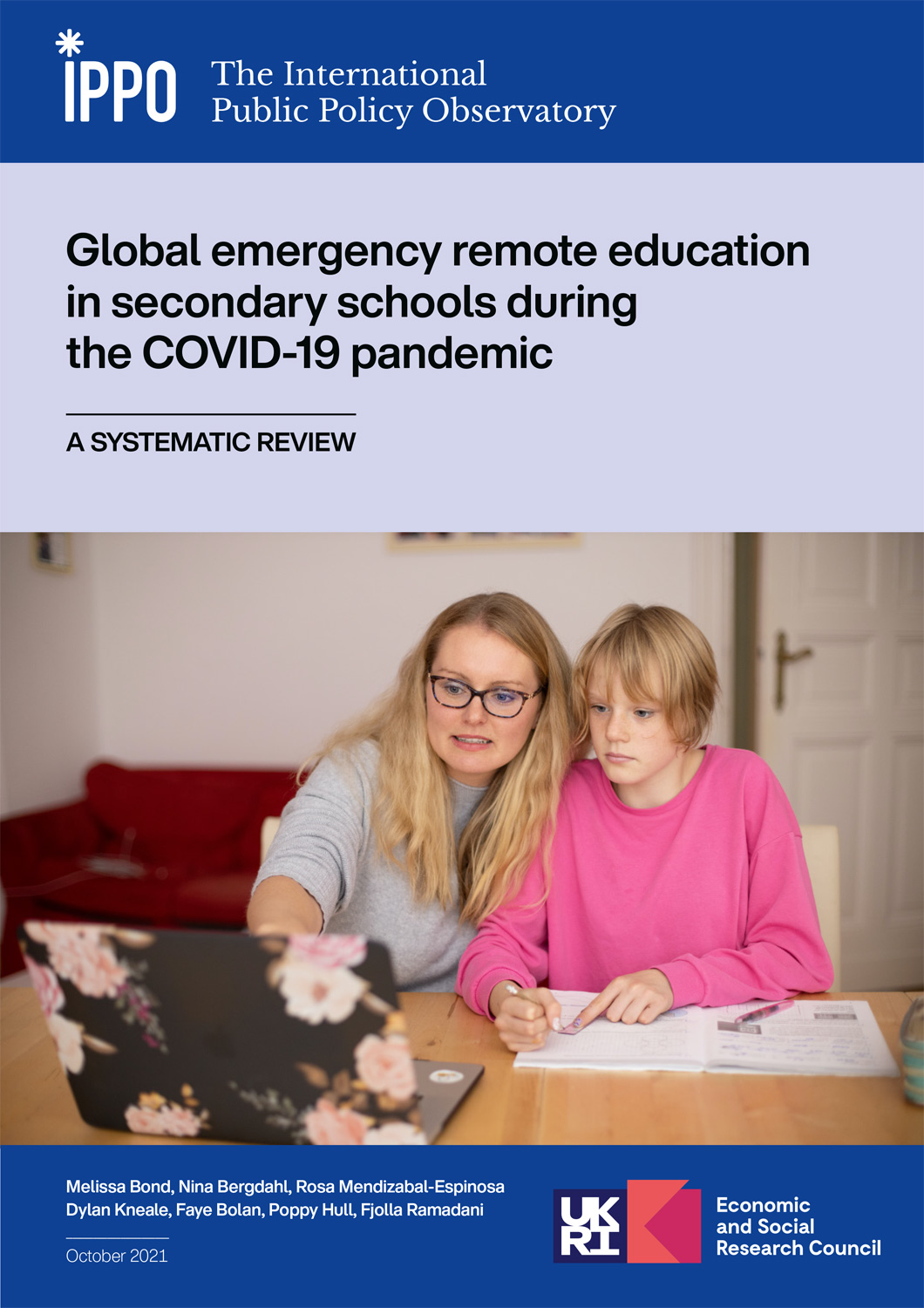The classroom of the future: how has COVID-19 changed the ways children learn and teachers teach?

Drawing on IPPO’s new global review of remote education initiatives during the pandemic, one of the report’s authors assesses which online learning tools and techniques are likely to remain a fixture of school learning for the long term
- Read a summary of the findings and recommendations here
Faye Bolan

Before 2020, online learning in schools mainly served as an add-on to ‘traditional’ teaching and learning, with pen-and-paper tasks and in-person instruction still very much the norm. In the nearly two years since COVID-19 emerged, however, the resulting school closures – affecting more than 1.7 billion students and families worldwide – have catapulted the status of online learning from non-essential to critical for education systems everywhere.
Despite the subsequent return to the classroom (although with large numbers of children still off school for COVID-related reasons), experts agree that education should not spring back to pre-pandemic norms. Rather, effective innovations introduced during the pandemic should be carried forward to ‘tool up’ and improve the quality of in-person teaching and learning. Indeed, a bold, evidence-based online learning strategy would not only improve the quality of learning for all, it would help mitigate the impact of the ongoing pandemic and future-proof education systems against ever-more likely crises, from pandemics to extreme weather events.
A chance for teachers to be creative
Weaknesses of existing online learning strategies in schools were laid bare by the rapid switch in 2020. Not only were there problems caused by unequal access to appropriate technology, but poorly designed online learning led to student disengagement. Both issues disproportionately affected already-disadvantaged students.
On the other hand, the emergency situation and ‘ad hoc’ approach to online learning gave teachers the chance to be creative and innovate. A wealth of data was collected throughout the course of the pandemic on what online learning approaches were taken, and what worked well in different contexts.
To untangle the wide variety of approaches taken and provide insights for future policy development, the International Public Policy Observatory (IPPO) has carried out a systematic review of evidence from the first year of the pandemic relating to secondary schools. The full review contains insights from students, teachers and parents from 38 countries and focuses on the topics of student engagement, peer collaboration, assessment and parental engagement relating to online learning. Drawing on these findings as well as the expert insights contributed at IPPO’s roundtable events, here we suggest a potential vision of what the ‘classroom of the future’ could look like.
Teachers can become more effective ‘facilitators’ of learning
During the pandemic, poorly designed online learning with little consideration for students’ social needs led to poor attendance and feelings of being overwhelmed. The traditional model of education, with teachers as disseminators of information and students as somewhat passive learners, did not translate well to the remote setting.
With online learning, teachers can become more effective ‘facilitators’ of learning by using the online space to enhance education and encourage self-learning in the classroom. The diverse tools, resources and methods made available mean teachers can employ a wider range of strategies to engage and motivate students, and to provide a more dynamic dimension to children’s learning experiences.
For example, videos and recorded teacher feedback that students can replay in their own time were popular tools used during school closures. Making use of re-usable content and a greater variety of teaching tools not only creates a more enjoyable and varied learning experience for students, it can also help to ease teacher workloads and lead to greater job satisfaction.
Building resilient classrooms of the future
Going forward, if teachers were to use the abundant resources developed through the course of the pandemic to deliver the course material (rather than always using the traditional ‘live classroom lesson’ approach), their time, expertise and, crucially, understanding of their students could be better used by spending more time on feedback and focusing on tricky topics.
Online learning and educational technology (EdTech) could allow students to take a more active role in their learning – for example, by enabling more constructive peer collaboration and creating better independent learners, in both remote and face-to-face settings. Learning analytics data from online learning platforms may allow students to move through material at their own pace, while flagging to teachers the topics on which students spend most time. Such uses of technology would enable teachers to provide truly bespoke guidance, thereby using valuable in-class time more effectively.
The perceived usefulness of the many EdTech tools introduced during the COVID school closures varied, but learning management systems (LMS) – ‘all-in-one’ portals where students access learning materials, submit work, receive feedback, carry out assessments and communicate with teachers – were particularly popular.
Technology in education is here to stay, and multipurpose platforms that are easy to use anywhere could even act as a backup in the case of teacher or student absence. However, with increasing reliance on tech comes increasing complexity. Issues such as having to sign-on to multiple platforms and having enough data storage capacity need to be addressed upfront to cope with this growing digitisation of the education sector.
With education technologies advancing at a remarkable rate, teacher training also has to keep up this pace. Disparities between teachers who were confident with digital technologies and those who struggled to adapt became evident during the pandemic. The current model of one-off training events when a school adopts a new EdTech tool may not be sufficient if schools are to incorporate more online learning approaches. Ongoing and integrated digital skills training throughout a teacher’s career, with a focus on technology designed for a clear purpose rather than for the sake of it, will be essential for building resilient and effective classrooms of the future.
A positive outcome for parents
One positive outcome of the period of online learning was that parents had a greater understanding of their children’s education. In some cases, communication with teachers and the school improved.
Parental engagement in learning is proven to have a beneficial effect on students’ academic outcomes; therefore, introducing EdTech tools that allow parents to see their children’s progress, contact teachers and find support in one accessible place would benefit students, teachers and parents alike. During the pandemic, parents’ evenings in the UK have been held online; both parents and teachers have reported that the online format improves communication, and means parents who cannot physically attend can still engage with their children’s learning.
However, some parents lack adequate digital skills to meaningfully assist their child with online learning tools. To combat this, schools and local authorities could provide training for parents when a new EdTech tool is introduced, to prevent some students from falling behind.
Where is more research needed?
IPPO’s systematic review contains many insights on the ways in which online learning and novel technologies could be incorporated into secondary schools going forward, to create a more effective, equitable and modern education system. But our work has also highlighted a number of gaps in the evidence, so future research would be welcome in these areas.
For example, standardised assessments such as GCSEs and A-levels were scrapped across the UK, provoking chaos and confusion for students and their families. While informal assessments such as quizzes and games are easy to do online, conducting formal exams and strategies to combat cheating remains an issue.
The increased reliance on video conferencing and the internet also raised concerns around safeguarding and cyberbullying for young students. If classrooms are to adopt more online learning in the future, safeguarding policies need to adapt to this rapidly evolving online environment.
Finally and perhaps most importantly, there is limited specific evidence on the best approaches to online learning for students with special educational needs and disabilities, and other marginalised groups with additional needs. Online learning, both in and out of the classroom, has the potential to create a more bespoke, fair and effective education offer – but only when the needs and means of all groups are considered.
While secondary school education will and should take place in person whenever possible – due to the vital social-emotional learning and development taking place at this age – aspects of online learning that improve engagement, stimulate curiosity and increase accessibility should be taken forward into the classrooms of the future.
A progressive, innovative and future-proof online learning strategy, drawing on the data collected during the pandemic and summarised in our review, will help ensure continuity of education even in times of crisis, and prepare our young people for an evolving and increasingly digital society.
Faye Bolan is a PhD researcher at the University of Manchester, and a co-author of IPPO’s global systematic review of emergency remote education initiatives during COVID-19
